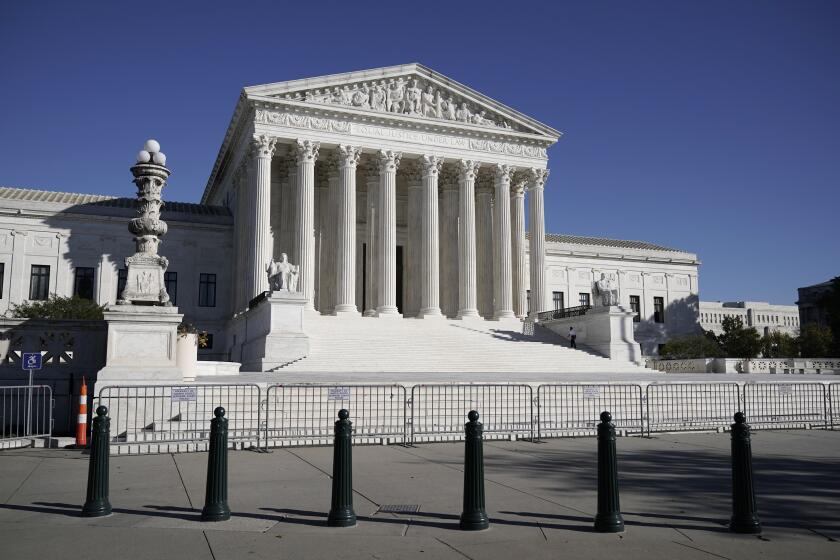Another Piece of Iraq’s Dark Past Tumbles
It began as another step to rid Iraq of its Baathist past, but before it ended, the two-hour effort Sunday to pull down a statue of the country’s onetime president Ahmed Hassan Bakr turned into a snapshot of the turmoil and raw emotion that grips this American-occupied capital more than a month after the war appeared to end.
The small group that had gathered in the middle of a southern Baghdad traffic circle to destroy the monument suddenly found itself ambushed by local residents and passersby, angry that anyone would waste energy on such a task when entire neighborhoods still lack electricity and water.
In a scene more akin to Speaker’s Corner in London’s Hyde Park than the heart of what had been one of the world’s most ruthless dictatorships, clusters of Shiite Muslims argued for an end to any reminder of their dark years of oppression, others vented their rage at the misery of everyday life under U.S. rule, while some just stood back and listened almost transfixed as they watched a scene unfold that would have been unthinkable just weeks ago: an open, freewheeling political debate.
“Instead of pulling down this statue, you should go half a kilometer down the road and do something for those at the gas station,” suggested Nabil Mustafir, a 43-year-old computer scientist who lives a short walk away. “I used to fill up in 10 minutes. Now you wait for 18 hours and get 50 liters,” about 13 gallons, of gasoline.
Clearly struggling to keep a grip on his emotions, Mustafir shouted that his business was ruined because there was no power to run his computers, that his family sweltered in a home with neither fans nor air conditioning and that his wife couldn’t venture out because of the poor security situation.
“We are a patient people, but for how long?” he asked a foreigner. “Please, please, do something.”
But other voices had little time for such talk.
“How can you speak of security with that statue still standing?” asked a young man of the only likeness of the former president in the city. “It’s a symbol of fear.”
Still others argued that Bakr -- a leading Baathist figure whom Saddam Hussein ousted in 1979 -- had been mild in comparison with Hussein himself.
With the event’s organizers caught off guard, the debate’s momentum seemed to be flowing away from them. As other locals joined the verbal fray, the truck-mounted crane positioned nearby to help topple the monument drove off. Soon soft drink vendors showed up, selling cans of Pepsi and 7Up for the equivalent of about $1 each.
About 45 minutes into the debate, reinforcements arrived for the organizers, and the tide began to turn. A Shiite cleric, Mohammed Bakr Basri, appeared, telling those who gathered how the Baathist regime had killed a close relative. Out of nowhere, others materialized, unfurling banners that left little doubt about their sympathies.
“Exterminate Baathist Criminals,” read one. “Shame on Those Who Cooperate With Killers,” declared another.
As Basri reasoned with groups of onlookers, a barrel-chested man with a black beard and a booming voice who called himself Abu Islam stoked the crowd with tales of Hussein-era atrocities.
Moments later, resistance broke.
One young man scrambled atop the plinth and banged on the statue with his shoe, while another draped a woman’s nightgown over the late president’s right hand to hoots of delight from those watching. A third began beating on the statue’s head with a long metal pipe as he screamed, “Allahu akbar” -- God is great. Soon, a flatbed truck with a small loading crane was flagged down as it moved around the traffic circle, and its driver quickly maneuvered his vehicle into place and began pulling on a chain that had been draped around Bakr’s neck and body.
When that effort failed, a far larger, mobile construction crane was halted by the group and quickly put to work. By this time, even those initially opposed to the idea seemed to get swept up by the crowd’s enthusiasm.
Mustafir, who an hour earlier had spoken so passionately against the statue’s destruction, had gone home for his children and now snapped their picture for posterity in front of the doomed monument.
An ambulance stood close by, just in case, as did three U.S. Army Bradley fighting vehicles, which were parked at a more discreet distance.
An initial push from the larger crane sent the statue’s head falling to the ground, where a group of young men led by Abu Islam first pounced on it, then carried it off triumphantly at a run.
By the close of the second hour, the monument was down completely and Basri, the Shiite cleric, grabbed the ambulance megaphone to shout in celebration. Within minutes, a group of men had tied the statue to the rear of their car and dragged it away.
One more image of Iraq’s Baathist past had passed into history.
More to Read
Sign up for Essential California
The most important California stories and recommendations in your inbox every morning.
You may occasionally receive promotional content from the Los Angeles Times.







